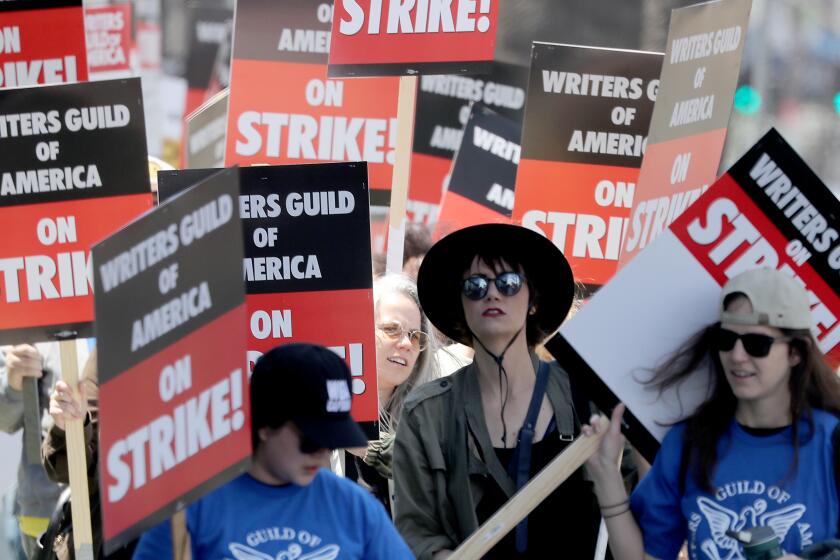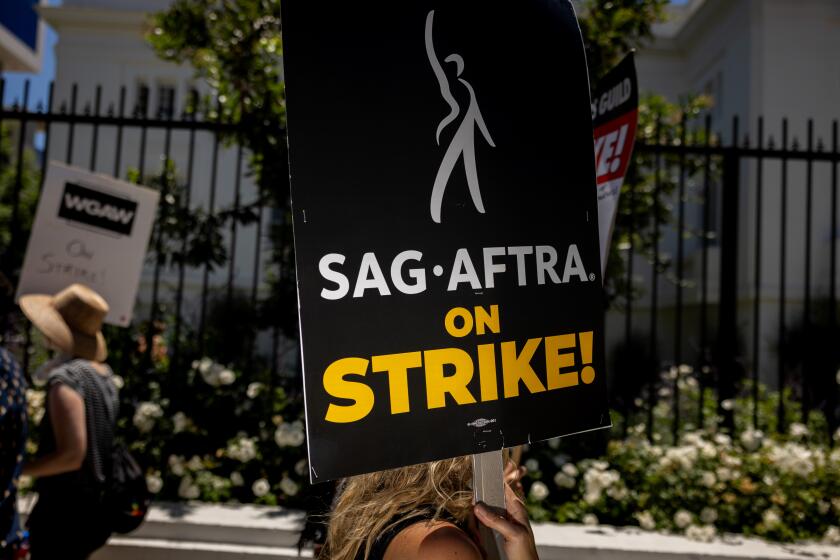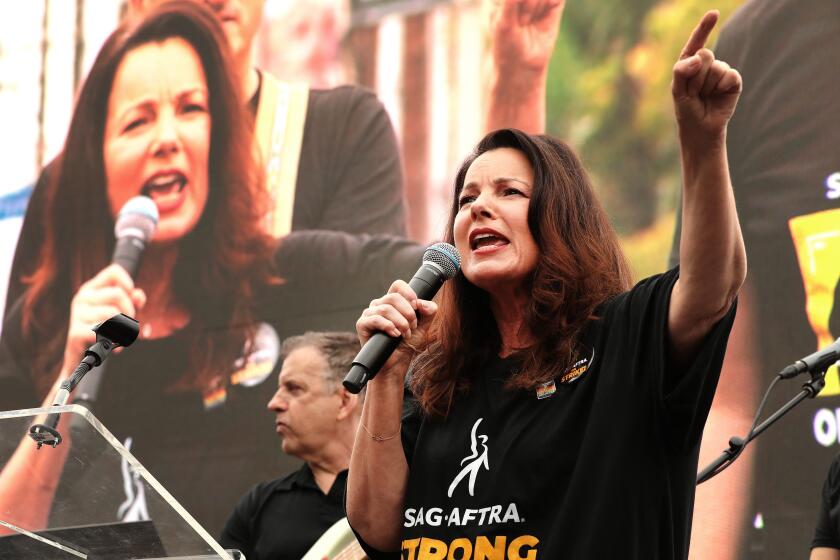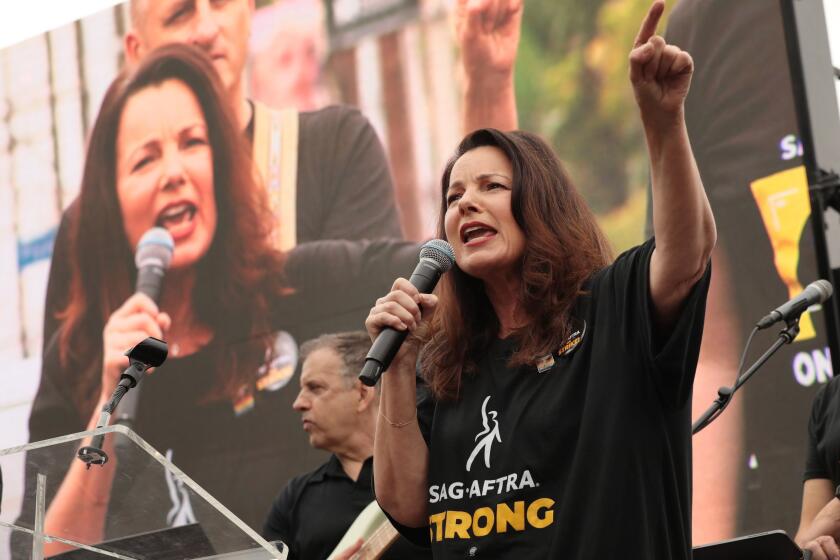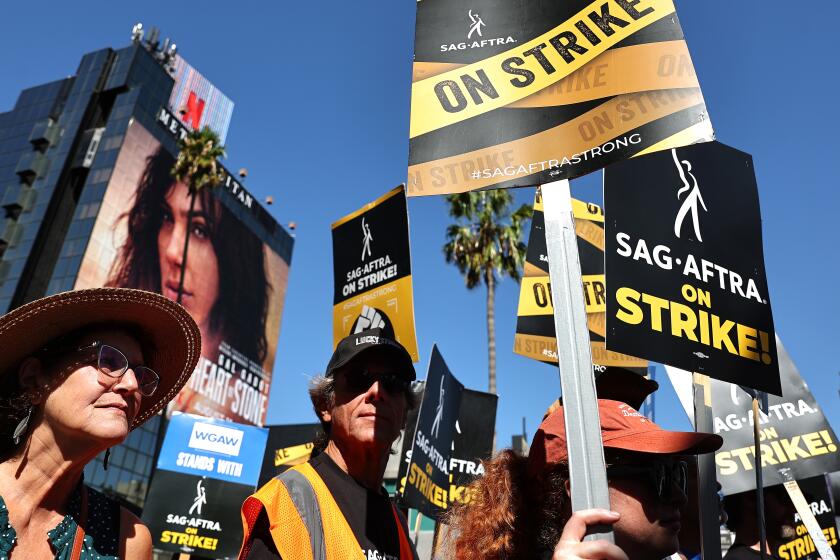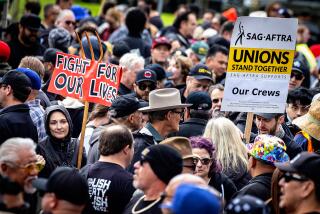Labor unrest defined Hollywood in 2023. Here’s what we learned from the twin strikes
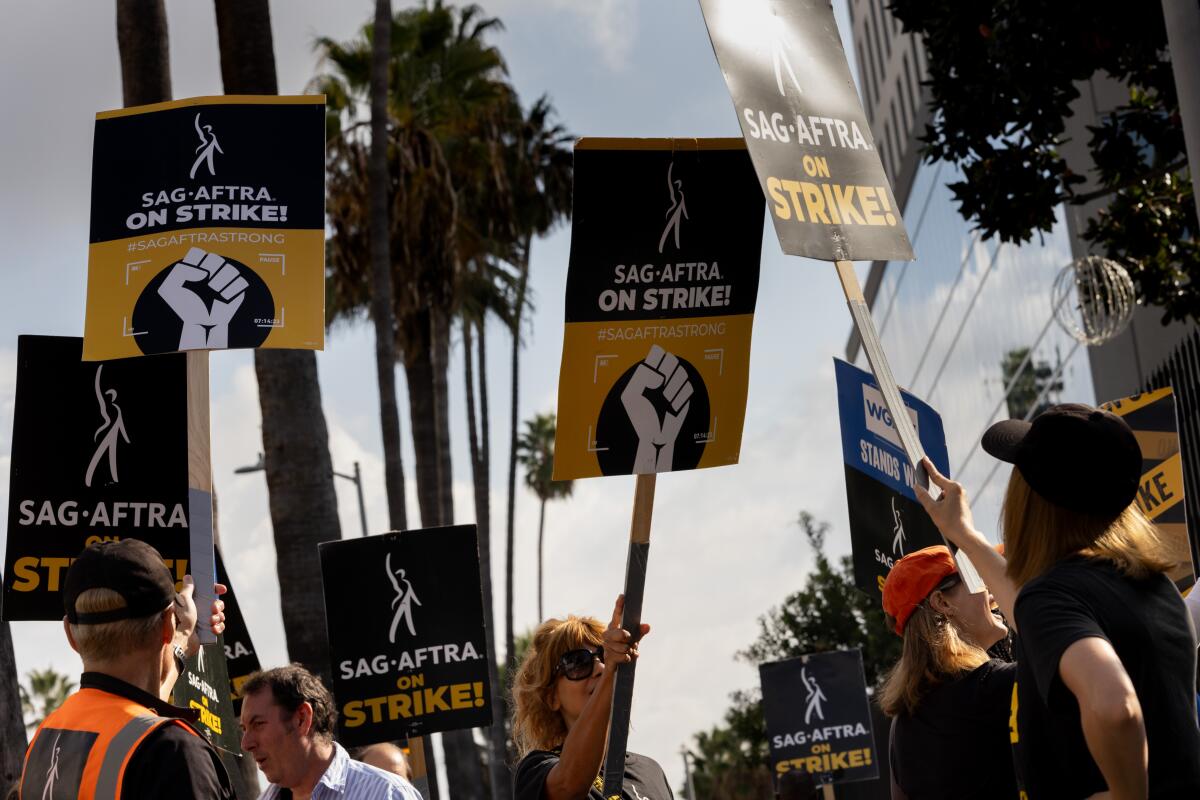
- Share via
Writers dropped their pens and picked up megaphones. Movie and TV stars walked picket lines instead of red carpets. A sitcom legend became the face of the entertainment labor movement.
This was the year that two of the most essential parts of the Hollywood machine — the storytellers and the performers who bring those stories to life — took a stand against their employers, shining a spotlight on the plight of working artists and bringing one of California and the country’s most powerful industries to its knees.
WGA President Meredith Stiehm never harbored any doubts about the efficacy of going on strike. She did worry, however, about whether members of the Writers Guild of America would be able to stick it out for as long as it would take to reach a resolution with the Alliance of Motion Picture and Television Producers. The stoppage lasted 148 days.
Hollywood’s twin strikes translated into a lost year of production for much of the industry with productions idle since last spring. SAG-AFTRA’s strike against major media companies stretched 118 days.
“We didn’t know ... if people could make it,” Stiehm told The Times. “A lot of writers went into [the strike] broke. ... It actually shows you what a bad situation we were in. People were in such an existential crisis that they were willing to say, ‘Yep, we have to strike.’ ... And they stayed together for so long.”
The back-to-back strikes brought historic gains for writers and actors — including boosts in streaming pay and protections against the spread of artificial intelligence — and demonstrated the growing clout of union activism in Hollywood and elsewhere.
But the unprecedented labor disruptions by the WGA and the Screen Actors Guild-American Federation of Television and Radio Artists that spanned six months also took a heavy toll on Southern California’s entertainment economy and the thousands of workers and small businesses that depend on it.
Since the writers went on strike in May, entertainment employment in the Greater Los Angeles area has decreased by about 17%, according to a study released in December by the Otis College of Art and Design in conjunction with Westwood Economics and Planning Associates. Before the walkouts, about 142,652 workers were employed in Hollywood, per the Bureau of Labor Statistics. As of October, that number had dropped to 117,853.
The 2023 writers’ strike is over after the Writers Guild of America and the Alliance of Motion Picture and Television Producers reached a deal.
The fallout has prompted many to wonder what can be done to avoid a sequel when the next round of negotiations begins less than three years from now.
“Some effort, some sort of dialogue, some sort of relationship building, trust building is going to be necessary” between the guilds and the studios moving forward, said Dave Smith, professor of economics at Pepperdine’s Graziadio Business School.
“I think [the studios] may have underestimated what we’ve seen as this rise ... in leverage on the side of labor throughout the economy, not just in Hollywood. And so I think it’s in their better interest now to seek those sorts of relationships so they can be ready when contracts come up.”
SAG-AFTRA has approved a deal from the studios to end its historic strike. The actors were on strike for more than 100 days.
The AMPTP declined to comment for this story.
For many guild leaders and rank-and-file members, the main takeaway from the summer is that strikes can be effective.
Mario Corona, an actor known for “Elysium,” “Guardia-García” and the Mexican telenovela “Las Aparicio,” said that the strikes helped actors and writers develop better ways to communicate their needs and express themselves.
He hopes that studio executives and the AMPTP gain a greater appreciation for human talent and the craft of acting.
“The strike ... was a pivotal moment, an inflection point,” Corona said. “This contract can have a ripple effect all over the world and with some of the actors unions from across the globe. ... That’s a positive thing.”
Workers in film and TV, most of whom are pro-union, have been trying to make ends meet amid a dual strike of Hollywood actors and writers.
Corona said he was comforted that workers in other industries, such as airport and hotel staffers, also took to picket lines.
“That was a sign for me to say ... ‘We’re not the only ones,’” Corona said. “‘We’re not alone.’”
Erin T. Hill, assistant professor of media and popular culture at UC San Diego, said that striking actors and writers benefited from a “perfect storm of what’s been going on with everyone’s job throughout the country.”
“The fact that these two unions basically joined forces ... has shown everybody how important it is to have more than one union ... organizing either together or in concert with each other,” Hill said.
By forcing the writers’ and actors’ strikes, the studios cost the California economy more than $5 billion and caused untold anguish. Those wounds won’t heal overnight.
Although there were substantial issues that fueled the labor unrest around streaming pay and AI, the tensions were deepened by mistrust on both sides. Studio executives made a number of PR blunders that didn’t help their cause, observers noted.
While attending a Rocky Mountain retreat for millionaires and billionaires in July, Disney boss Bob Iger called guild members’ demands “unrealistic,” and he was subsequently raked over the social media coals. Weeks after the WGA strike began, Warner Bros. Discovery Chief Executive David Zaslav delivered a commencement speech at Boston University that drew boos and jeers from the graduating class in solidarity with writers.
“This was a great example of ... the strikers receiving almost the entirety of goodwill and these CEOs trying out their swagger,” Hill said. “They were not received well, and it didn’t help their case.”
“I will not cave,” “The Nanny” star and SAG-AFTRA President Fran Drescher says in an interview, as the actors’ strike reaches 100 days. Talks with the major studios were suspended earlier this month.
Also standing side by side with actors and writers throughout the strikes were below-the-line workers from crew members’ union IATSE, which is set to renegotiate its contract early next year.
Members of the International Alliance of Theatrical Stage Employees — lighting and sound technicians, carpenters, makeup artists, set decorators, costume designers and others who work behind the scenes on film and TV sets — were among the hardest hit during the dual walkouts, which brought production to a standstill for much of 2023.
Set decorator Nya Patrinos — who has worked on film and TV projects such as “Pam & Tommy,” “Transparent” and “The Morning Show” — was among the thousands of IATSE members who suffered from the massive production slowdown.
Three months into the actors strike, Americans still tend to sympathize more with SAG-AFTRA than the studios, according to a new poll.
Even the few jobs Patrinos did manage to book during the production drought ended up not moving forward. She eventually took a gig on a low-budget film that she considered “a step backward” in her career just to stay employed.
Despite the hardships, however, Patrinos said that morale among crew members is good and that the various locals and committees that make up her union have been meeting to discuss gender-pay equity, diversity, inclusion and other topics they hope will be addressed in upcoming contract negotiations.
“I think there’s an idea — because we’re all freelancers or gig people — that we can’t sustain a strike,” said Patrinos, chair of the diversity, equity and inclusion committee for IATSE Local 44. “But we really believe in better working conditions. We really want to progress. We don’t want to lose ground. And we’re willing to put everything on the line for that.”
As the studios walk away from negotiations yet again — this time with the actors — they are going back to a losing playbook. And Hollywood stands to suffer.
The big question heading into 2024 is whether IATSE members will have the appetite for a walkout if negotiations break down, given the toll of the work stoppages in 2023. The union has traditionally avoided showdowns with the studios, though it narrowly averted the first nationwide strike in its 130-year history in 2021.
The guild aims to tackle issues such as AI, funding of pension and health benefits and fair compensation, as well as “many unique, craft-specific matters that will also require the earnest attention of the employers” during contract negotiations, said Vanessa Holtgrewe, assistant department director of film and TV production at IATSE.
“Striking is not the goal, but it’s not off the table,” Holtgrewe said in an email. “We’re going to be aggressive and do what it takes to secure deals that satisfy the priorities members set.”
More to Read
Inside the business of entertainment
The Wide Shot brings you news, analysis and insights on everything from streaming wars to production — and what it all means for the future.
You may occasionally receive promotional content from the Los Angeles Times.

